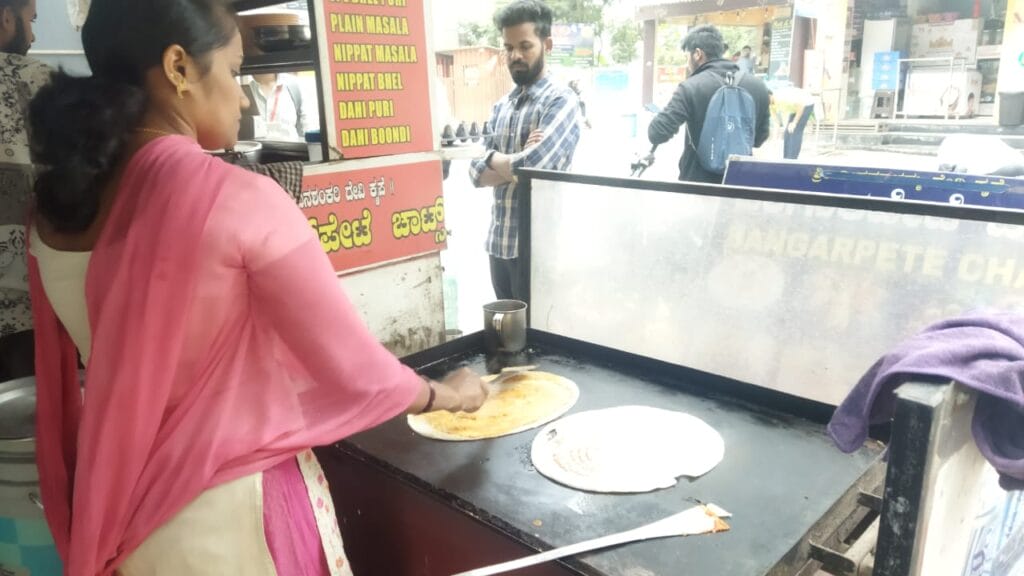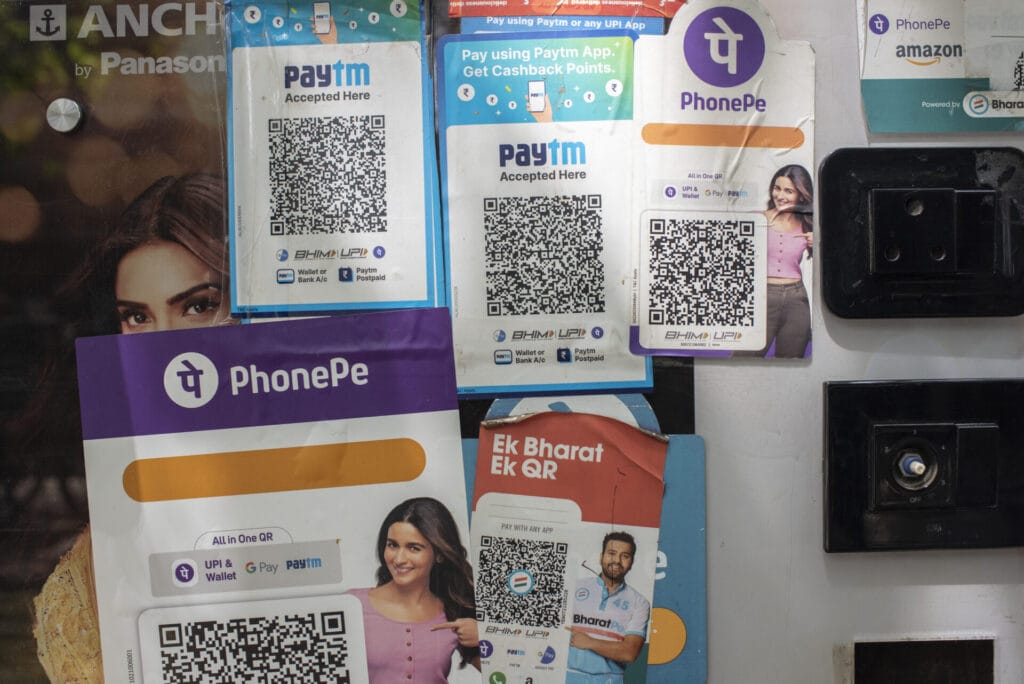Mita (name changed) is here, there and everywhere, managing her shop alone in Salt Lake, Kolkata as she juggles her spatula, pots, pans, paper plates, teacups, and dish soap. In the midst of this apparent chaos, she does some deft mental arithmetic to calculate dues, and tells her customers, “The QR code is displayed there.”
Mita is one among the wide cross section of the Indian population who have adopted United Payments Interface (UPI)—a real-time, cash-less and secure payment system. The National Payment Corporation of India (NPCI) introduced UPI in 2016 to facilitate inter-bank transactions for peer-to-peer, or individual-to-merchant transactions. Its popularity has been bolstered by public and private sector banks promoting UPI-based micropayments. The number of UPI users went up to 83,751.14 million transactions in the financial year 2022-23.
When introduced, UPI was celebrated for facilitating ease of business, especially as it trickled down to the informal economy. Its effect on the business practices of women street vendors was applauded, particularly for initiating them into financial institutions. Data that we collected between December 2023 and July 2024 in two Electronic Cities– Bengaluru and Kolkata, on women vendors’ everyday experiences of using UPI, particularly QR codes in doing business, reveals some interesting and untold experiences.
Read more: What are the demands of Mumbai’s street vendors?
Ease in business due to technology
The use of QR codes in vending stalls with live kitchens depends on various things: the nature of the fare sold, the ability to physically handle cash between preparing customer’s orders, the number of working hands in the stall, and the general flowchart of the work.

For instance, when Mita started using UPI payments, she thought that her multitasking would reduce, but it became more complicated, as the screen would not respond to wet fingers while she tracked payments. However, the arrival of the soundbox, now rented out by almost all the fintech companies to the businesses, provides relief making it simpler for both Mita and her customers.
All the women street vendors that we spoke to, including Mita, Sitamma and Aparajita (names changed) agreed that handling finances has become much easier than before with the adoption of UPI-based transactions. Dealing with cash and providing loose change created cumbersome, stressful and unsettling situations, especially during peak business hours when they had to deal with multiple male customers, impatient for their change to be returned. In such situations, there were often gendered remarks made about their ability to calculate, ranging from numerical inability to cunningness.
Some of the respondents emphasised the increased sense of security due to the usage of UPI transactions as it reduces the need to carry cash all the time and, in turn, the chance of it getting misplaced or stolen. A few also said that the worry about receiving fake currency, especially the higher denominations, has reduced to almost zero, this being particularly important for vulnerable and marginal informal vendors.
Read more: Why it is important to recognise streets as ‘places of work’

Gendered challenges
The financial inclusion of women through technology like UPI, however, is not as simple as pasting a QR code. When her husband fell sick and could not attend the shop, Mita convinced him to go for UPI. He agreed on the condition that the khata [ledger] would have to be maintained alongside the UPI payments.
Mita adds, “I did not have a smartphone, and I used to call him after each payment to find out whether the transaction had gone through. He insisted that the UPI account should be his own. I thought that it would be better for the cash transactions to be handled between him and the bank. I just focused on the work.”
Often, women are excluded from making financial decisions and forming direct relationships with financial institutions. They receive less hands-on training and information than their male counterparts, resulting in lower familiarity with online payment technologies and cash flow processes.
One of the most important takeaways that have emerged from our conversations is that complete digitisation may reinforce women’s role as mere labour in their own stalls.
Globally, the gender gap in the number of male and female adults with mobile money accounts is higher than the gender gap in bank account ownership. Women are 20% less likely than men to own a smartphone or simply borrow a phone from a male family member under the supervision of the latter. In developing countries, only 41% of women have access to the internet, compared to 53% of men.
In many of the instances cited here as well, digital payment provided a convenient mode of financial engagement between the men and the banking institution. The wives running the stalls can neither access credit or financial services for furthering their businesses nor can they access cash through debit cards.
Therefore, the assumption that UPI payments are a sure-shot way to establish relationships between women vendors and financial institutions — as projected in advertisements — has to be re-evaluated.
Read more: Push government to implement all welfare measures in Street Vendors Act : Lekha Adavi
Social impact of UPI transactions
The discussions with respondents opened up another important aspect of business–customers buying any product on credit. According to these women vendors, earlier, they experienced two credit-related situations. Firstly, without adequate change, customers would take the product and pay later, thus placing the burden of remembering, noting and collecting the due amount on the (women) vendor. Now, customers and vendors do not need to worry about exact change. This has partly ironed out some issues in the vendor-customer relationship.
Secondly, the women vendors in Kolkata maintain a rolling account (or baaki khaata), which helps create and maintain a loyal customer base and augment social relations. This is especially important for food vendors who sell affordable rice-based meals to a loyal customer base of wage workers, who get paid weekly or fortnightly, and settle their accounts depending on the cash flow.
Several vendors in Kolkata pointed out that the baakir khata and khuchro (loose change) are the bases of social relationships that develop as a network and a buffer zone within the market relationships, forming in normal times as well as in the face of income insecurity. These are gradually getting uprooted by the QR code’s fast and instant transactions.
Reconciling new workflows with traditional methods
The discussion with women vendors highlights their experiences with cashless transactions, particularly during and after the COVID-19 pandemic. During and in the aftermath of the pandemic, cashless methods like UPI offered advantages such as reducing the anxiety of virus transmission while handling cash and also freeing up time, allowing vendors to focus more on the family.
But digital transactions bring with them their own share of challenges. Vendors report difficulties in tracking payments, especially during busy times, and the unavailability of UPI-based daily transaction ledgers with same-day transaction records complicates accounting. Many still keep manual ledgers to reconcile UPI transactions.
Then, there are missing transactions in bank accounts. Vendors also face issues with customer service when such problems arise. “Banks cannot be blindly trusted; often, there are missing transactions, which I keep flagging. Talking to customer care is another headache,” says Mita, based on her experiences. When asked about the ease of navigating customer care, she says, “Sometimes it is impossible, but if I let go, I lose money.”
Reliance on cash remains crucial for transactions within the supply chain, where many actors across the supply chain deal in cash, complicating financial management and relationships with suppliers. Matters get complicated when their husbands are unwilling to part with cash.
In the final analysis, all the vendors interviewed said that access to cash was important in itself. “Our businesses always run on credit; however, regular clearance of accounts with suppliers would make it simple. The absence of cash poses a major block”. Thus, it has to be acknowledged that while UPI-based transactions have brought about several positive changes in the lives of women vendors, they cannot be seen as an exclusive or sufficient tool to ensure the financial inclusion of women.
Note: Sections of the field work for the research in Kolkata was done with the support of the Hawker Sangram Committee. This article has been structured with assistance from Shruti Gokarn, Reporter for Citizen Matters.
Also read:
- Mumbai hawkers in limbo: Government offers loans but continues eviction drives
- More heat, less business: Street vendors struggle as temperatures soar in Mumbai
- Bengaluru’s street vendors are the first to be impacted by climate change: Lekha Adavi